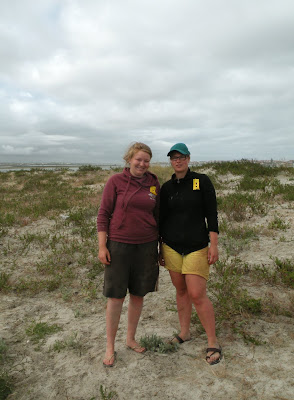Let's recapitulate the past week, we have been a bit slack in putting up new pictures and stories, but we were all busy.
BBQ
Shrimp, fish, meat, potatoes and veggie burgers all fit nicely on a BBQ. It is such a pleasure to have a device like that in your back garden and a very friendly landlord who puts up the lights for you. Portugal is a great country, never mind the crisis.
 |
| BBQ at Edificio Sao Gabriel |
This is one of the things that I love about my job. The other one is
the contacts with students. "I was waiting for you to tell me where and
when to measure discharge in our area, but after some time I concluded
that you were not going to tell me this. So we went out and did it
ourselves" is what Abdi told me over a nice salad. That's exactly what
we want and our students never disappoint us. Field courses are the
best!!!
The island study
Leonie and Evy decided to spend the night on the tiny island in the Ria de Aveiro and do half-hourly measurements of waterlevels and electrical conductivity in water extracted from minifilters at different depths in the groundwater to see the changes over a full tidal cycle. So we bought a tent, a good flashlight and a warm pizza and off they were. I know, this sounds easy, but it was tough staying up all night after a full day of work. They made it through the night and a drowsy looking couple greeted us on the island the next morning, all ready to leave except that we still needed to do some measurements...
 |
| Leonie picking us up in early morning |
 |
| Evy and Leonie having received yellow-ape medals of honour for their 24-hour continuous research shift on the island. |
Vincent had to leave shortly after for a conference in Buzios, Brazil, but the we shall continue here, and later in the Netherlands to report about this.
Hydrochemical sampling and placing a piezometer
Meanwhile, in the Vagos area 17 other MSc students are still doing their thing. This was mostly taking water samples because these need send by courier for analysis in the laboratory in NL, before we all return in two weeks. You have seen the frantic activity of the Mesas group to take a river water sample in the previous entry and below is the sampling of groundwater by the Tabuaco group in a VU piezometer.
 |
| Sietse getting water from an old Nora well for comparison with piezometer water |
 |
| Tabuaco group doing field chemical analysis of pH, alkalinity, EC and nitrate on groundwater |
But it is not always that easy. Sure, this part of Portugal is littered with open wells that have groundwater in them, but how representative is that water when it has rainwater, fish, snakes, algae and sometimes rubbish or fertiliser bags floating in it. So sometimes you have to decide to take the extra effort get to the pristine groundwater from where it is hidden deep in the soil and do a piezometer installation.
This is exactly what the Presa Velha and Sao Romao groups concluded, after noticing that the piezometers placed by groups in the previous years had mysteriously dissappeared (we did found yellow tape and the piezometer cap). Transit arrives, auger is taken out, people walk around looking for the perfect piezometer installation point and the drilling begins.
 |
| Augering a hole for piezometer installation |
Start with soil description and some sampling of the unsaturated part for chloride profile determination.
 |
| Soil sampling for chloride profile in the unsaturated zone, nice silvery mica sands! |
When the hole is made, 4 m deep in this case, the piezometer is prepared with filter cloth around the screen and the thing is placed in the soil and the hole being backfilled.
 |
| Preparing the piezometer |
 |
| Finishing up installation as a team backfilling the hole. |
|
Then the first muddy water is pumped out to clean the piezometer. Sampling will be done later in the week...
Sapflow
We also installed four sapflow sensors to measure tree water
use. There was some discussion about whether to install eucalypt trees for a
week and then four pine trees for the next week or to measure the flux in two
pine trees and two eucalypt trees for two weeks. The ‘polder model’ also works
in Portugal and so the students decided to first measure four eucalypt trees
for four days, then two eucalypt trees and two pine trees for four days, and
then finally measure water use in four pine trees for the last four days so
that they can look at the differences in water use between the species and
relate the water use patterns to the evaporation rates obtained from the
weather station.
 |
Lex installing the first sapflow sensor, Robin making sure
that he does it right, and Donavon holding the sensor.
|
 |
| Installing sapflow sensors is fun (or are they laughing at the high-tech drill?) |









No comments:
Post a Comment